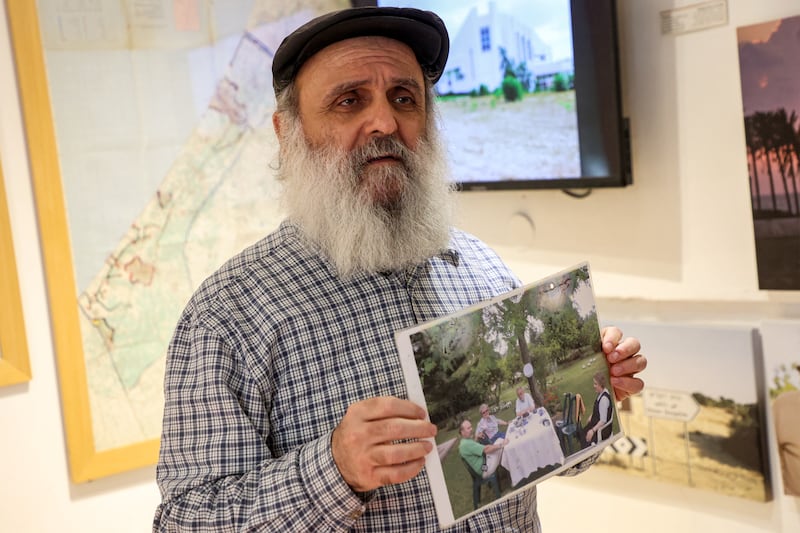The 2005 disengagement, when all 21 Jewish settlements in the Gaza Strip were evacuated, along with a full military withdrawal, remains an open sore for the religious Zionist right-wing camp in Israel.
In January, three months into the Gaza war, thousands of right-wing activists attended a conference in Jerusalem, calling for the government to rebuild Jewish settlements in Gaza. Eleven government ministers and 15 coalition lawmakers, including from prime minister Binyamin Netanyahu’s ruling Likud party, attended the gathering even though Netanyahu has said renewing Jewish settlement in Gaza is not one of Israel’s war aims.
The renewed interest in all things Gaza has led to a large increase in visitors to the Gush Katif museum at the edge of Jerusalem’s Mahane Yehuda fruit and vegetable market. Gush Katif was the area in southern Gaza along the Mediterranean coast where most Gaza settlements were located. Today the area is known by its Arabic name al-Mawasi, and was designated as a humanitarian zone for residents displaced in the war.
The small museum was set up by a Gaza settler evacuee in 2008 and tells the story of the Jewish presence in the area, the 35 years of settlement following the 1967 Six-Day War – when Israel captured Gaza from Egypt – and what is referred to as “the expulsion” undertaken by the government of then prime minister Ariel Sharon, once a top general idolised by the right in Israel.
READ MORE

Oded Mizrahi (63) from Jerusalem, who runs the museum today, explains that Gaza is an integral part of the biblical land of Israel, beginning with the birth in the area of the patriarch Isaac (Yitzhak), the only son of Abraham and Sarah.
“If we don’t control Gaza then we won’t be able to drink cappuccino in Tel Aviv in peace. It’s as simple as that,” he explains as he gives me a guided tour of the museum.
“And what about the more than two million Palestinians who live there?” I ask him.
“It was good for them when we controlled Gaza and they worked in our communities. Until we started signing peace agreements and giving them territory. Their answer was war and terror and the establishment of Hamas. When they smell weakness they want to destroy us. Whoever accepts this is a Jewish state can stay. Whoever uses terror against us will be destroyed or expelled,” he claims. “It would have been ideal if they had fled to Egypt during this war but Egypt doesn’t want them. We gave them the entire Gaza Strip until the last inch but all they did was build tunnels and prepare for war.”
Much of the focus of the museum is the 18-month struggle against the disengagement, during which tens of thousands of activists tried to make their way past police and army barriers to reach the settlements for a last stand to prevent the eviction of the families from their homes.
The trauma was real. I remember coming across my doctor from Jerusalem, a West Bank settler who had gone to Gaza to join the protest, as I covered the dramatic events as a journalist in Neve Dekalim, the largest Gush Katif settlement. He told me that those days were the worst of his life. He had ripped his shirt in a traditional sign of mourning for observant Jews, representing the tear in one’s heart when losing a loved one.
Today the right-wing makes a direct link between the Gaza war and the disengagement. “We told you this would happen if we left Gaza,” they say. They are right about the warnings but there may be many other plausible reasons to explain the events of October 7th.
For Oded Mizrahi it’s all about religious belief.
“The problem is not with the Arabs but with the Jews who have lost their roots and don’t understand what they are doing here. This is why Sharon decided to flee Gaza after 35 years – because he had no religious roots. The secular liberals and progressives are destroying everything here because they don’t understand what we are doing here. Binyamin Netanyahu has roots but he is an acrobat. We would like a better leader but at the moment he’s the best option we have and definitely better than the left.”
The Gush Katif museum features a huge eight-branched Jewish menorah candelabrum that was removed from the roof of the synagogue in the Netzarim settlement in Gaza before the community was destroyed. The menorah was brought to the Western Wall in Jerusalem before being denoted to the museum. Another menorah exhibited in the museum was made from a Hamas Kassam rocket that landed in one of the Gaza settlements but failed to explode.
Mizrahi hopes the items will be returned if the Jewish presence is reestablished in the coastal enclave.














